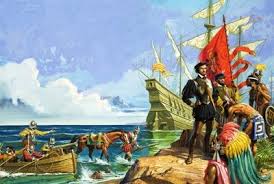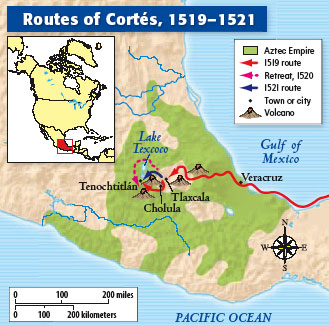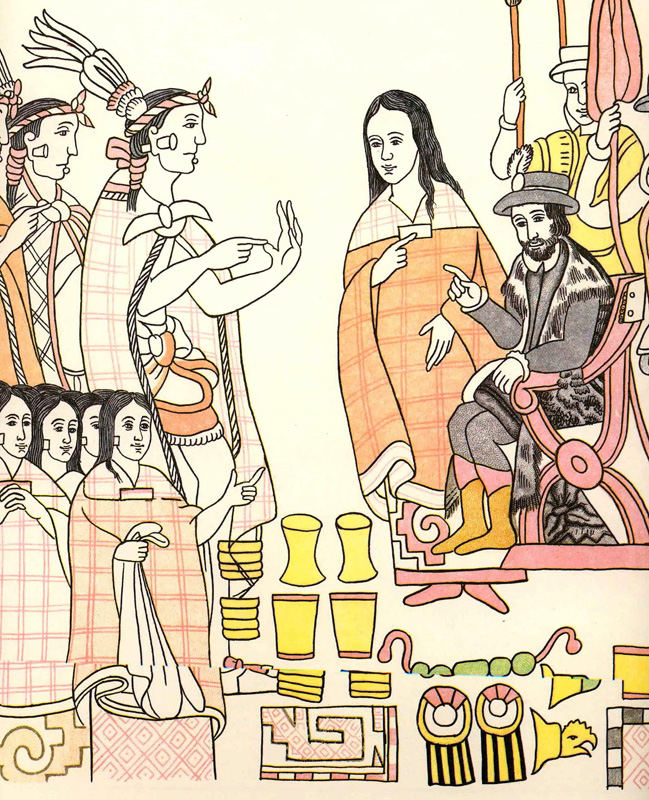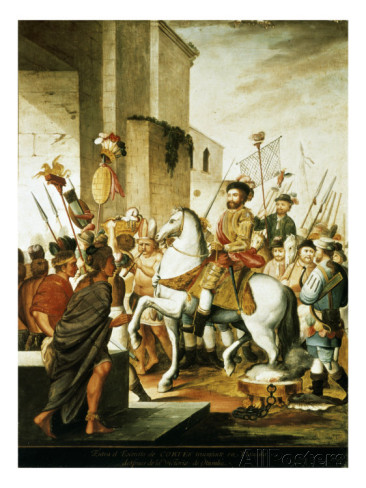Muslim pirate Barbarossa wrecked havoc in the Mediterranean in the early 1500s, raiding the coasts of France, Italy and Spain, carrying away thousands of Europeans into slavery.

Muslim Turks had conquered the Byzantine Empire, and under
Sultan Suleiman the Magnificent, were invading Serbia, Hungary, Bulgaria and surrounding Vienna, Austria, in 1529.

For centuries
Muslim Arab, Turk, Mughal and Afghan conquerors killed tens of millions of Hindus and Sikhs in India and the East.

During this time,
the Spanish soldier proved to be the most successful champion in defending Christendom.
Spain's
King Ferdinand ended the 700 year Muslim occupation of western Europe. Using gold from the New World, Spain pushed back the Muslim invaders on land and sea.

Just two years after Martin Luther began the Reformation, on the other side of the world, 34-year-old
Hernan Cortés landed in
Central America in 1519 with the mixed motives of "God, Glory and Gold."

In what he believed to be a holy cause,
Cortés told his small army:
"
Soldiers of Spain, we are standing upon the verge of the greatest adventure ever undertaken by so small a body of men.

We now leave the known world behind us: from this time forth we plunge into a region never before trodden by men of our race or religion.
The hazards of this adventure I shall not dwell upon; they are well estimated by the bravest among you...

The shores we shall storm are lined with teeming millions of savages, unfriendly if not openly hostile.
We have only our swords and our good right arms to protect us against their overwhelming numbers.

Therefore let not childish strife or inner dissension weaken the front we must present to the enemy.

If we go as united as we go courageously, we have nothing to fear, nothing to lose...
We are marching as Christians into a land of infidels.
We seek not only to subdue boundless territory in the name of our Emperor Don Carlos, but to win millions of unsalvaged souls to the True Faith."
 Cortés
Cortés ordered his ships sunk. There was no turning back.

With 500 men, 16 horses and 10 cannons,
Cortés set out from Vera Cruz on February 10, 1519, toward
Tenochitlan - Mexico City.
 Mexico City
Mexico City was the capital of the
Aztec Empire, which ruled Central America after the
Mayan civilization peaked around 900 AD.
 The Aztec Empire
The Aztec Empire consisted of 6 million people stretched over 200,000 square miles.

As Americans today are shocked by reports of Planned Parenthood cutting out baby body parts and selling them,
Cortes' troops were likewise shocked by gruesome sights, such as:

-prisoners with their hearts cut out;
-pyramid style temples covered with human blood; bodies of men and boys without arms or legs;
-human skulls stacked on poles;

-hundreds of thousands of human skulls arranged in piles;
-gnawed human bones piled in houses and streets;

-wooden houses built with grates jammed with captives awaiting sacrifice;
-pagan priests with hair matted with dried blood, the stench of carrion, sodomy; and
-sacrificed humans rolled down temples where frenzied hoards ate them.

This was part of their religion which believed the Sun god needed human blood to live and that the Aztecs were responsible to feed him daily with captives from other tribes.

As the Spanish troops went from town to town, other Indian tribes were elated with hopes of being freed from Aztec rule which required them to provide youth for sacrifices.
 Cortés
Cortés men freed captives, rolled idols down temple steps and erected crosses.

Francisco Lopez de Gomara,
Cortés' personal secretary and chaplain, reported how they found in Cozumel a Catholic priest,
Gerónimo de Aguilar. He had been shipwrecked on Yucatan eight years earlier and had learned the language:

"So
Gerónimo de Aguilar preached to them about salvation, and, either because of what he told them, or because of the beginning they had already made, they were pleased to have their idols cast down,
and they even assisted at it, breaking into small pieces what they had formerly held sacred...

...And soon our Spaniards had left not a whole idol standing, and in each chapel they set up a Cross or the image of Our Lady, whom all the islanders worshipped with prayer and great devotion...
They begged
Cortés to leave someone behind to teach them to believe in the God of the Christians; but he did not dare consent, for fear they might kill the preacher, and also because he had few priests and friars with him.
And in this he did wrong, in view of their earnest request and supplications."

In giving battle instructions,
Cortés exhorted:
"Sirs, let us follow our banner which bears the sign of the Holy Cross, and through it we shall conquer!"

After defeating the Aztec ally Tabascan tribe,
Cortés preached through interpreter
Gerónimo de Aguilar, as reported by Francisco Lopez de Gomara:
"
Cortés told them of their blindness and great vanity in worshipping many gods and making sacrifices of human blood to them,
and in thinking that those images, being mute and soulless, made by the Indians with their own hands, were capable of doing good or harm.

He then told them of a single God, Creator of Heaven and earth and men, whom the Christians worshiped and served, and whom all men should worship and serve.
In short, after he had explained the Mysteries to them, and how the Son of God had suffered on the Cross, they accepted it and broke up their idols.

Thus it was that with great reverence, before a large concourse of Indians, and with many tears on the part of the Spaniards, a Cross was erected in the temple of Potonchan, and our men first, kneeling, kissed and worshiped it, and after them the Indians."
 Doña Marina
Doña Marina, a Nahua woman from the Mexican Gulf Coast, became interpreter for
Cortés, and later his mistress, with whom he had his first son, Martín, one of the first "Mestizos" -a person of European and indigenous American descent.

When ambassadors from
Montezuma arrived bearing gifts,
Cortés took the opportunity to preach through his interpreter.
Bernal Diaz del Castillo, a soldier who served with
Cortés, recorded the scene:
"When
Tendile and
Pitalpitoque saw us thus kneeling, as they were very intelligent, they asked what was the reason that we humbled ourselves before a tree cut in that particular way.
As
Cortés heard this remark he said to the
Padre de la Merced who was present:

'It is a good opportunity, father, as we have good material at hand, to explain through our interpreters matters touching our holy faith'...
And then he delivered a discourse to the Caciques so fitting to the occasion that no good theologian could have bettered it.
After telling them that we were Christians and relating all matters pertaining to our holy religion, he told them that their idols were not good but evil things which would take flight at the presence of the sign of the cross, for on a similar cross the Lord of Heaven and earth and all created things suffered passion and death;

that it is He whom we adore and in whom we believe, our true God, Jesus Christ, who had been willing to suffer and die in order to save the whole human race; that the third day He rose again and is now in heaven; and that by Him we shall all be judged.
 Cortés
Cortés said many other things very well expressed, which they would report them to their prince Montezuma.
Cortés also told them that one of the objects for which our great Emperor had sent us to their country was to abolish human sacrifices and the other evil rites which they practiced."

Meeting resistance with the Cempoallan tribe, a Spaniard suggested accommodating their practices.
Cortés adamantly replied:
"How can we ever accomplish anything worth doing for the honor of God if we do not first abolish these sacrifices made to idols?"

Upon reaching Tenochitlan (Mexico City), Montezuma asked Cortés if he was the god
Quetzalcoatl, who was predicted to return from the east as a white man with a beard and blue eyes,
to stamp out human sacrifice and deliver the oppressed.
 Cortés
Cortés replied:
"It was true that we came from where the sun rose, and were the vassals and servants of a great Prince called the Emperor Don Carlos, who held beneath his sway many and great princes,
and that the Emperor having heard of him and what a great prince he was, had sent us to these parts to see him, and to beg them to become Christians, the same as our Emperor and all of us, so that his soul and those of all his vassals might be saved."
 Montezuma
Montezuma was in awe of
Cortés and his men, primarily because of the ominous portents and signs that had recently occurred which were interpreted as foretelling Quetzalcoatl's return and the end of the Aztec Empire, namely:

-water of the lake around Mexico City boiling over due to volcanic eruption,
-unusual northern lights,
-comets,
-earthquakes,
-the temple of the sun god catching fire,
-eerie wailing noises at night,
and the king's sister revived from her grave saying strange beings would enter the country and ruin it.
 Montezuma
Montezuma showed
Cortés and his men their temples.
There was a theater made of human skulls and mortar, wherein Gonzalo de Umbria counted 136,000 skulls, which included those in the steps and on poles.

A tower was made of skulls too numerous to count.
There were obsidian knives, stone altars, black-robed priests with hair matted down with human blood, idols with basins for human blood, walls and steps covered with human blood and gore,
an idol made out of seeds kneaded and ground with the blood of virgins and babies, pits where the human bodies were thrown after people had eaten off the arms and legs.
 Bernal Diaz del Castillo
Bernal Diaz del Castillo recorded:
"
Our Captain said to
Montezuma through our interpreter, half laughing:

'Señor
Montezuma, I do not understand how such a great Prince and wise man as you are has not come to the conclusion, in your mind, that these idols of yours are not gods, but evil things that are called devils and so that you may know it and all your priests may see it clearly, do me the favor to approve of my placing a cross here on the top of this tower.'"

According to Bernal Diaz del Castillo's account,
Cortés discoursed with
Montezuma further:
"We told them we were Christians and worshipped one true and only God, named Jesus Christ, who suffered death and passion to save us, and we told them that a cross (when they asked why we worshipped it) was a sign of the other Cross on which our Lord God was crucified for our salvation;

and that the death and passion which he suffered was for the salvation of the whole human race, which was lost, and that this our God rose on the third day and is now in heaven, and it is He who made the heavens and the earth, the sea and the sands, and created all the things that are in the world, and He sends the rain and the dew, and nothing happens in the world without His holy will.

That we believe in Him and worship Him; but that those whom they look upon as gods are not so, but are devils, which are worse, and they could see that they were evil and of little worth, for where we had set up crosses such as those his ambassadors had seen, they dared not appear before them, through fear of them, and that as time went on they would notice this..."

Bernal Diaz del Castillo's account continued:
"
Cortés explained to him very clearly about creation of the world, and how we are all brothers, sons of one father and one mother who were called Adam and Eve,

and how such a brother as our great Emperor, grieving for the perdition of so many souls, such as those which their idols were leading to Hell, where they burn in living flames,
had sent us, so that after what he (Montezuma) had now heard he would put a stop to it and they would no longer adore these idols or sacrifice Indian men and women to them, for we were all brethren, nor should they commit sodomy or thefts.

He also told them that, in the course of time, our Lord and King would send some men among us who lead very holy lives, much better than we do, who will explain to them all about it, for at present we merely came to give them due warning.
And so he prayed him to do what he was asked and carry it into effect."
 Cortés
Cortés suddenly left for the coast when he got word that a Spanish expedition led by Narváez was sent to fight him.

In
The Greatest Killer: Smallpox in History (University of Chicago Press, 1983, p. 205), Donald R. Hopkins wrote:
"The Governor of Cuba (Velasquez), who had sent
Cortés to Mexico in the first place...yielding to suspicions of
Cortés' loyalty...dispatched another expedition led by
Pánfilo de Narváez...with orders to supercede
Cortés..
T
he epidemic of smallpox then raging in Cuba, said
Governor Velasquez, prevented him from leading the new expedition himself (Bancroft 1883, 9: 358)...

...
Narváez left Cuba in early March, can landed at Cempoala, near present-day Vera Cruz, on 23 April 1520.
According to D'Ardois (1961) and Smith (1974), it was
an African slave in
Narváez's entourage,
Francisco de Baguia, who
first introduced smallpox to the American mainland...
The "Great Fire" (smallpox) that
Narváez's expedition brought ashore accidentally assured
Cortés' victory (over the Aztecs)."

Spanish friar, Fray Toribio Motolinia, described the epidemic in his
History of the Indians of New Spain (1541):
"At the time
Captain Pánfilo de Narváez landed in this country, there was in one of the ships a negro stricken with smallpox, a disease which had never been seen here.
At this time New Spain was extremely full of people, and when the smallpox began to attack the Indians it became so great a pestilence among them throughout the land that in most provinces more than half the population died. (Foster 1950, 38)"

During the fighting,
Cortés' men most likely came in contact with the disease, which they unsuspectingly brought back to
Mexico City.
 Cortés
Cortés returned to find the city in chaos.
The troops
Cortés had left in Mexico City panicked during a loud Aztec ceremony and fired a cannon into the crowd, killing many.
 Cortés
Cortés fought his way back into the palace and had
Montezuma try to quell the uproar.
Aztec priests pelted
Montezuma with rocks and he soon died.
Get the book American Minute-Notable Events of American Significance Remembered on the Date They Occurred

Bernal Diaz del Castillo recalled:
"
Cortés wept for him, and all of us Captains and soldiers, and there was no man among us who knew him and was intimate with him, who did not
bemoan him as though he were our father, and it is not to be wondered at, considering how good he was."
 Cortés
Cortés fought his way out of the city with great loss to his ranks, and fled back to the coast.
After several months of recovery,
Cortés decided to mount a last final attack on Mexico City.

On December 26, 1520,
Cortés addressed his force of 540 soldiers and 40 cavalry, who were armed with 80 crossbows and 9 muskets, saying:
"My brothers, I give many thanks to Jesus Christ to see you now cured of your wounds and free from sickness. I am glad to find you armed and eager to return to Mexico to avenge the deaths of your comrades and recover that great city.
This, I trust in God, we shall soon do, because we have with us Tlazcala and many other provinces, and because you are who you are, and the enemies the same as they have been, and we shall do so for the Christian Faith that we proclaim...
 Cortés
Cortés continued:
The principal reason for our coming to these parts is to glorify and preach the Faith of Jesus Christ....
We cast down their idols, put a stop to their sacrificing and eating of men, and began to convert the Indians during the few days we were in Mexico

It is not fitting that we abandon all that good that we began, rather, we should go wherever our Faith and the sins of our enemies call us.
They, indeed, deserve a great whipping and punishment, because, if you remember, the people of the city, not satisfied with killing an infinite number of men, women, and children in sacrifices to their gods (devils, rather), eat them afterward, a cruel thing, abhorrent to God and punished by Him, and one which all good men, especially Christians, abominate, forbid, and chastise..."
 Cortés
Cortés concluded:
"Moreover, without penalty or shame, they commit that accursed sin because of which five cities, along with Sodom, were burned and destroyed.
Well, then, what greater or better reward could one desire here on earth than to uproot these evils and plant the Faith among such cruel men, by proclaiming the Holy Gospel?
Let us go, then, and serve God, honor our nation, magnify our King, and enrich ourselves, for the conquest of Mexico is all these things. Tomorrow, with the help of God, we shall begin."
 Cortés
Cortés and his men returned to find Mexico City devastated by smallpox. The ill and weakened Aztecs were defeated and the great Aztec Empire fell.

Bernardino de Sahagún's personal history of the conquest, completed in 1585, confirmed:
"Among the Mexicans who fell victim to this pestilence was the lord Cuitlahuactzin, who they had elected a little earlier. Many leaders, many veteran soldiers, and valiant men who were their defense in time of war, also died."
 Cortés
Cortés captured
the last Aztec ruler, Cuauhtémoc, and later tortured him to find gold.
Cortés then personally ruled Mexico till 1524.
Though conquistadors
greedy for gold and glory treated native people harshly, soon came
missionaries motivated by the Gospel, such as
Bartolome' de las Casas, who sincerely wanted to better the condition of Indians.

From a broader perspective, the world powers at the time were Spain, Portugal, the Muslim Ottoman Empire and China.

These massive empires had centuries of experience fighting with gunpowder, horses, steel, catapults, siege machines, and enormous ships, like China's Ming Dynasty Treasure Fleet.

The peoples of the Americas, through no fault of their own, had none of these, not even a wheelbarrow, which was invented in China over a millennium earlier during the Han Dynasty.
The New World, sooner or later, was most likely going to conquered by one of these world powers, it just happened to be Spain.

In 1531, on
Tepeyac Hill outside of the former Aztec capitol of
Mexico City, the story of Indian Juan Diego and
"Virgin of Guadalupe" resulted in an estimate 15 million Indians being baptized in the next 20 years in what many consider the largest mass conversion in history.
 Cortés
Cortés traveled back and forth to Spain, and even joined a fleet in 1541, commanded by the Italian Admiral
Andrea Doria, to fight the infamous
Muslim Turkish Barbary pirate, Barbarossa of Algiers.
 Cortés
Cortés died in Mexico on DECEMBER 2, 1547.
Driven by the mixed motives of
"God, Glory and Gold," Cortés had inscribed on his coat of arms the Latin phrase:
"Judicium Domini apprehendit eos, et fortitudo ejus corroboravit bracchium meum."
(The judgement of the Lord overtook them; His might strengthened my arm.)
